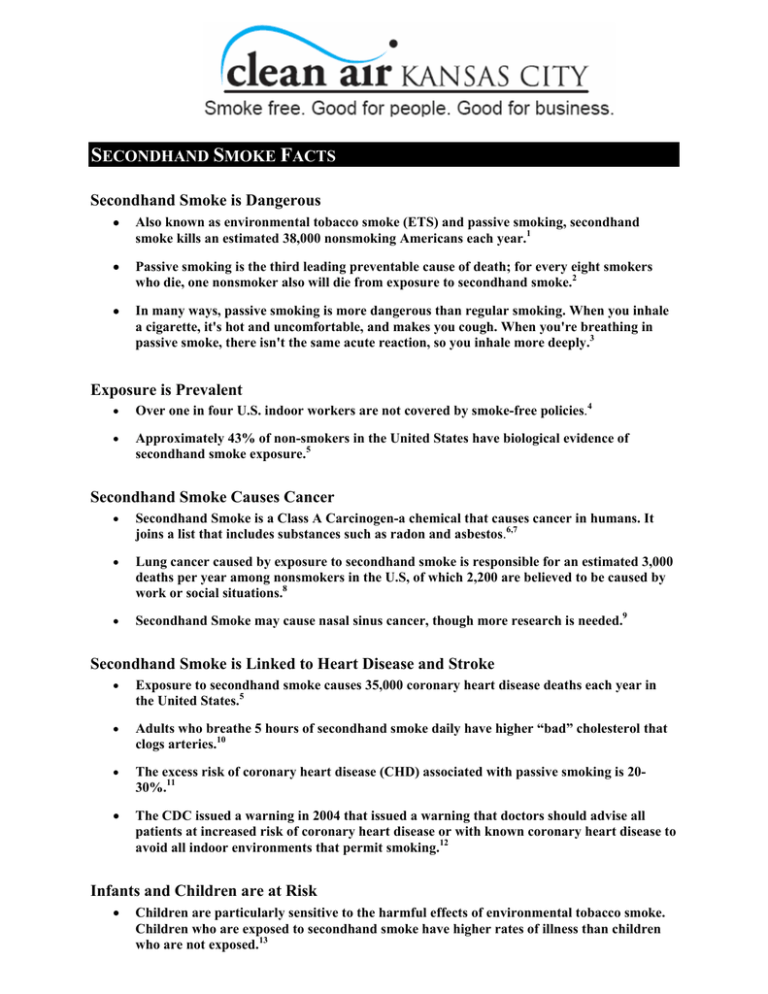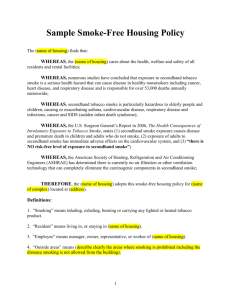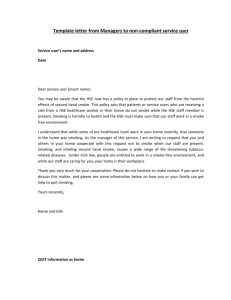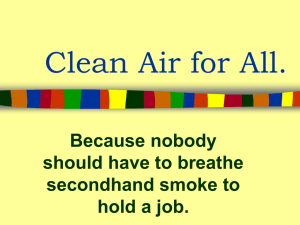S F ECONDHAND
advertisement

SECONDHAND SMOKE FACTS Secondhand Smoke is Dangerous • Also known as environmental tobacco smoke (ETS) and passive smoking, secondhand smoke kills an estimated 38,000 nonsmoking Americans each year.1 • Passive smoking is the third leading preventable cause of death; for every eight smokers who die, one nonsmoker also will die from exposure to secondhand smoke.2 • In many ways, passive smoking is more dangerous than regular smoking. When you inhale a cigarette, it's hot and uncomfortable, and makes you cough. When you're breathing in passive smoke, there isn't the same acute reaction, so you inhale more deeply.3 Exposure is Prevalent • Over one in four U.S. indoor workers are not covered by smoke-free policies.4 • Approximately 43% of non-smokers in the United States have biological evidence of secondhand smoke exposure.5 Secondhand Smoke Causes Cancer • Secondhand Smoke is a Class A Carcinogen-a chemical that causes cancer in humans. It joins a list that includes substances such as radon and asbestos.6,7 • Lung cancer caused by exposure to secondhand smoke is responsible for an estimated 3,000 deaths per year among nonsmokers in the U.S, of which 2,200 are believed to be caused by work or social situations.8 • Secondhand Smoke may cause nasal sinus cancer, though more research is needed.9 Secondhand Smoke is Linked to Heart Disease and Stroke • Exposure to secondhand smoke causes 35,000 coronary heart disease deaths each year in the United States.5 • Adults who breathe 5 hours of secondhand smoke daily have higher “bad” cholesterol that clogs arteries.10 • The excess risk of coronary heart disease (CHD) associated with passive smoking is 2030%.11 • The CDC issued a warning in 2004 that issued a warning that doctors should advise all patients at increased risk of coronary heart disease or with known coronary heart disease to avoid all indoor environments that permit smoking.12 Infants and Children are at Risk • Children are particularly sensitive to the harmful effects of environmental tobacco smoke. Children who are exposed to secondhand smoke have higher rates of illness than children who are not exposed.13 • Secondhand smoke causes between 700,000 and 1.6 million visits to the doctor for children 18 months and younger for childhood ear infections.14 • When a pregnant woman is exposed to secondhand smoke, her unborn baby is also exposed. Babies of mothers exposed to secondhand smoke have nicotine in their hair at birth.15 • Secondhand smoke is a known preventable cause of low birth weight, which contributes to infant mortality and health complications into adulthood.16 • The EPA estimates that between 150,000 and 300,000 annual cases of lower respiratory tract infections in infants and young children up to 18 months of age are attributable to secondhand smoke exposure.14 • Secondhand Smoke exposure is a known cause of Sudden Infant Death Syndrome (SIDS).17 • Between 200,000 to 1,000,000 asthmatic children have their condition worsened by exposure to secondhand smoke.18 Benefits of Going Smoke-Free 1 • Smoke-free laws help protect restaurants and bar employees and patrons from the harmful effects of secondhand smoke.19 • Because smoke-free ordinances in public places encourage smokers to stop smoking, the policies help reduce tobacco-related healthcare costs.20 • Smokers who worked in communities with strong ordinances were 38% more likely to quit smoking than smokers in communities with no ordinance.21 • Adolescents who worked in a smoke-free workplace were found to be 32% less likely to smoke than adolescents who worked in a workplace with no smoking restrictions.22 • Smoke-free workplaces are associated with a 5% to 6% decline in smoking prevalence and an average reduction in cigarette consumption of 2.3 cigarettes per day per smoker.243 National Center For Chronic Disease Prevention and Health Promotion. Secondhand Smoke Factsheet. February 2004 available at http://www.cdc.gov/tobacco/factsheets/secondhand_smoke_factsheet.htm 2Glantz, S. & Parmley, W., AHA Circulation, 1991; 83: 1-12.) 3 Dr. Derek Raghaven, Director, Cleveland Clinic’s Cancer Center. Larry King Live. March 7, 2006. 4The Health Consequences of Involuntary Exposure to Tobacco Smoke: a Report of the Surgeon General, 2006. 5The Health Consequences of Involuntary Exposure to Tobacco Smoke: a Report of the Surgeon General, 2006. 6U.S. Environmental Protection Agency, Respiratory Health Effects of Involuntary Smoking, 1993. 7Report on Carcinogens, Tenth Edition; U.S. Department of Health and Human Services, Public Health Service, National Toxicology Program, December 2002. Available at: http://ehp.niehs.nih.gov/roc/toc10.html. 8US Environmental Protection Agency. EPA Fact Sheet: All About Secondhand Smoke Effects. December 2004. Available online at http://www.ehso.com/SmokingAllAbout.htm. 9The Health Consequences of Involuntary Exposure to Tobacco Smoke: a Report of the Surgeon General, 2006. 10The Health Consequences of Involuntary Exposure to Tobacco Smoke: a Report of the Surgeon General, 2006. 11 The Health Consequences of Involuntary Exposure to Tobacco Smoke: a Report of the Surgeon General, 2006. 12 Pechacek, Terry F., Stephen Babb. How acute and reversible are the cardiovascular risks of secondhand smoke? British Medical Journal. April 24, 2004. Volume 328; pgs 980-983. Available online at http://bmj.bmjjournals.com/cgi/content/full/bmj;328/7446/980.13 US Surgeon General. The Health Consequences of Involuntary Smoking. Washington, DC: US Department of Health and Human Services, 1986. 14California EPA Report on Secondhand Smoke, Estimated Annual Morbidity and Mortality in Nonsmokers Associated with SHS Exposure, Table ES.2. 1997. 15Eliopoulos, Journal of the American Medical Association, 1994; 271:621-628. 16Dejmek, J.; Solansky, I.; Podrazilova, K.; Sram, R., "The exposure of nonsmoking and smoking mothers to environmental tobacco smoke during different gestational phases and fetal growth," Environmental Health Perspectives 110(6): 601-606, June 2002. 17The Health Consequences of Involuntary Exposure to Tobacco Smoke: a Report of the Surgeon General, 2006. 18"Fact Sheet: Respiratory Health Effects of Passive Smoking," U.S. Environmental Protection Agency, April 2004. 19Siegel, M “Involuntary Smoking in the Restaurant Workplace,” JAMA 270(4): 490-493, 1993. 20American Legacy Foundation, “Saving Lives, Saving Money: Why States Should Invest in a Tobacco-Free Future, March 28, 2002. 21Moskowitz, Lin, and Hudes, “The Impact of Workplace Smoking Ordinances in California on Smoking Cessation,” American Journal of Public Health, May 2000. 22Farkas, Gilpin, White, and Pierce, “Association Between Household and Workplace Smoking Restrictions and Adolescent Smoking,” Journal of the American Medical Association, August 9, 2000. 23 Evans, Farrelly, and Montgomery, “Do Workplace Smoking Bans Reduce Smoking?” NBER Working Paper Series 5567, May 1996.





